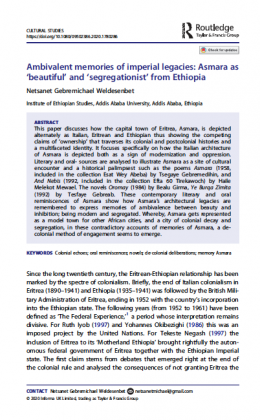
This paper discusses how the capital town of Eritrea, Asmara, is depicted alternately as Italian, Eritrean and Ethiopian thus showing the competing claims of ‘ownership’ that traverses its colonial and postcolonial histories and a multifaceted identity. It focuses specifically on how the Italian architecture of Asmara is depicted both as a sign of modernization and oppression.
Literary and oral- sources are analysed to illustrate Asmara as a site of cultural encounter and a historical palimpsest such as the poems Asmara (1958, included in the collection Esat Wey Abeba) by Tsegaye Gebremedihin, and
And Nebis (1992, included in the collection Efta 60 Tirekawoch) by Haile Melekot Mewael. The novels Oromay (1984) by Bealu Girma, Ye Burqa Zimita (1992) by Tesfaye Gebreab. These contemporary literary and oral reminiscences of Asmara show how Asmara’s architectural legacies are remembered to express memories of ambivalence between beauty and inhibition; being modern and segregated. Whereby, Asmara gets represented as a model town for other African cities, and a city of colonial decay and segregation, in these contradictory accounts of memories of Asmara, a decolonial method of engagement seems to emerge.
| File Name | Ambivalent-memories-of-imperial-legacies-Asmara-as-beautiful-and-segregationist-from-Ethiopia.pdf |
|---|---|
| File Type | |
| File Size | 1.26 MB |
| Total Downloads | 4,113 |
| Download |

